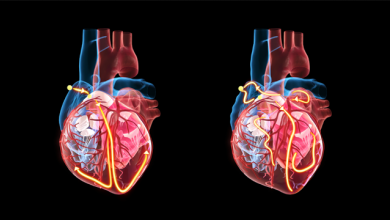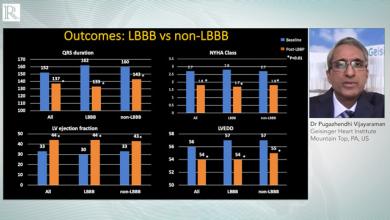Search results
Author(s):
Demosthenes G Katritsis
,
Mark E Josephson
Added:
3 years ago
Atrioventricular nodal reentrant tachycardia (AVNRT) denotes re-entry in the area of the AV node, and represents the most common regular arrhythmia in the human.1 Although several models have been proposed to explain the mechanism of the arrhythmia in the context of the complex anatomy and the anisotropic properties of the atrioventricular (AV) node and its atrial extensions (see Figure 1),2 the…
View more
Author(s):
Khang-Li Looi
,
Anthony SL Tang
,
Sharad Agarwal
Added:
3 years ago
Heart failure (HF) is a growing and major health burden in western countries. The prevalence of HF is estimated at 1–2 % in the western world, and the incidence approaches 5–10 per 1,000 persons per year.1Cardiac resynchronisation therapy (CRT) has been shown in multiplestudies to improve HF symptoms, quality of life and improve survivals.2–6The two landmark studies, Comparison of Medical Therapy…
View more
Author(s):
Amar Trivedi
,
Bradley P Knight
Added:
3 years ago
Hypertrophic cardiomyopathy (HCM), a genetic sarcomeric disorder associated with myocyte disarray and scar deposition, is intimately linked to sudden cardiac death (SCD) due to malignant ventricular arrhythmias. In the first modern published description of the disease in 1958, Dr Donald Teare describes the case of a 14-year-old male who collapsed while being chased around his school’s playground…
View more
Author(s):
Pugazhendhi Vijayaraman
Added:
3 years ago
Dr Pugazhendhi Vijayaraman (Geisinger Heart Institute, Mountain Top, PA, US) shares the results from the Left Bundle Branch Pacing for Cardiac Resynchronization Therapy study.
The aim of the study was to assess the feasibility and outcomes of LBBP in CRT eligible patients in an international, multicenter, collaborative study.
Questions:
1.What was the rationale for the study?
2.What patients…
View more
Author(s):
Haipeng Tang
,
Shaojie Tang
,
Weihua Zhou
Added:
3 years ago
Cardiac resynchronisation therapy (CRT) is a widely-performed standard treatment for improving cardiac function and quality of life in patients with heart failure.1 After CRT, however, 30–40 % of patients do not experience improvements in left ventricular (LV) function and clinical symptoms.2–3 The key factors for increasing the response rate to CRT are identification of the optimal LV lead…
View more
Defining LBBB Patterns in CRT
Author(s):
Roderick Tung
,
Gaurav A Upadhyay
Added:
3 years ago
Article
Author(s):
Deepika Narasimha
,
Anne B Curtis
Added:
3 years ago
Implantable cardiac devices such as implantable cardioverter- defibrillators (ICDs) and cardiac resynchronisation therapy (CRT) devices lead to improved survival and better clinical outcomes in appropriately selected patients with heart failure (HF) with a reduced ejection fraction (EF). Although there are significant sex differences in the aetiology, pathophysiology and clinical course of HF,…
View more
Conduction System Pacing
Author(s):
Ahran D Arnold
,
Zachary I Whinnett
,
Pugazhendhi Vijayaraman
Added:
3 years ago
Article
Author(s):
Angelo Auricchio
Added:
3 years ago
Despite the fact that more than 20 years have passed since the clinical introduction of cardiac resynchronisation therapy (CRT), one of the key questions – do we need an ICD for primary prevention of sudden cardiac death (SCD) in CRT patients? – is still unanswered.
Prospective Randomised Controlled Trials
Multiple prospective randomised controlled trials have been conducted to establish the…
View more















 « First
« First